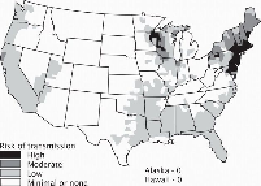Travel Reference
In-Depth Information
More information is available at
www.cdc.gov/ncidod/diseases/submenus/
Lyme Disease
Lyme disease is a combination of signs and symptoms related to infection by
Borrelia
burgdorferi
, an organism transmitted to humans from deer and mice by
Ixodes
ticks. Al-
though concentrated in the Northeast, upper Midwest, and Pacific coast, Lyme disease oc-
cases are diagnosed in the United States yearly, making it the most common vector-borne
illness in the country. Because the tick is so small, its bite frequently goes unnoticed. The
risk of developing Lyme disease from a tick bite in New England, where one-quarter to
one-half of all ticks harbor the organism, is only in the range of 1 to 5 percent. It is most
common in late spring and early summer. Disease is rare unless ticks remain attached for
more than twenty-four hours.
The first and most characteristic symptom, usually occurring three to ten days after ex-
posure, is a flat, red, expanding rash that sometimes clears in its center as it grows larger
andthatspontaneouslyfadesintwotofourweeks.Fever,malaise,andmuscleachesresem-
blinginfluenzamayaccompanytherash.Inthisstage,treatmentforfourteentotwenty-one
days with oral doxycycline, amoxicillin/clavulanate (Augmentin®), or cefuroxime axetil
(Ceftin®,Zinacef®)iseffective.Inlaterstages,whichmaybedaystomonthsaftertheori-
ginal illness, a more widespread rash, headaches, fatigue, a stiff neck, and pain and swell-
ing in joints and muscles may occur. Even later, in the third stage, serious nervous system,
joint, and skin complications may appear in untreated individuals. The diagnosis of Lyme
disease in later stages is based on blood tests for antibodies to the organism.
Treatment in the later stages is with different drugs or for longer times and is best un-
dertaken by a physician.
More information is available at
www.cdc.gov/ncidod/dvbid/lyme/index.htm
.
Figure 22-2. Categories of risk of Lyme disease in the United States
Leptospirosis

Search WWH ::

Custom Search